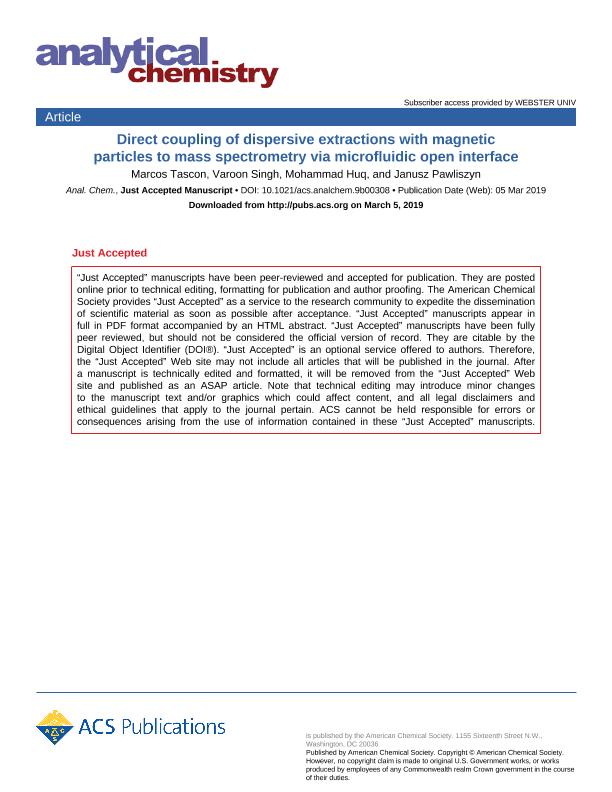Artículo
Direct Coupling of Dispersive Extractions with Magnetic Particles to Mass Spectrometry via Microfluidic Open Interface
Fecha de publicación:
04/2019
Editorial:
American Chemical Society
Revista:
Analytical Chemistry
ISSN:
0003-2700
Idioma:
Inglés
Tipo de recurso:
Artículo publicado
Clasificación temática:
Resumen
Microextraction coupled to mass spectrometry (MS) has great potential in analytical chemistry laboratories operating in a variety of fields. Indeed, microextraction methods directly coupled to MS can be of large value given that they can provide not only analyte extraction and enrichment but also effective sample cleanup. In recent years, the practicality in handling high active surface area, versatility, and environmentally friendly features of magnetic dispersive microextraction technologies has contributed to an explosion in the number of methods and technologies reported in the literature for a wide range of applications. However, to the best of our knowledge, no technology to date has been capable of efficiently merging these two rising concepts in a simple and integrated analytical workflow. In this context, the microfluidic open interface is presented for the direct coupling of dispersive magnetic extraction to mass spectrometry. This technology operates under the concept of a flow-isolated desorption volume, which generates a stagnant droplet open to ambient conditions while continuously feeding the ionization source with solvent by means of the self-aspiration process intrinsic of the electrospray ionization (ESI) interface. To improve the efficiency of the final analytical workflow, a novel dispersive magnetic micro- and nanoparticle extraction protocol for biofluid droplets was developed. The final methodology entailed the dispersion of a small amount of magnetic particles (20-70 μg) in a droplet of biofluid (≤40 μL) for extraction, followed by a particle collection step using a homemade 3D-printed holder containing an embedded rare-earth magnet. In the final step, the holder is set on top of the microfluidic open interface (MOI) for desorption in the isolated droplet. Switching the valve transfers the desorbed analytes to the ESI source in less than 5 s. As proof of concept, the completely new setup was applied to the determination of prohibited substances from phosphate-buffered saline (PBS) and human urine using Fe 2 O 3 magnetic nanoparticles (50 nm) functionalized with C 18 . The limits of quantitation (LOQs) obtained were in the low-ppb range in all cases, and acceptable precision (≤20%) and accuracy (80-120%) were attained. Also, taking advantage of the fast extraction kinetics provided by the radial diffusion associated with small particles, we employed the methodology for the selective extraction of phosphopeptides from 40 μL of tryptic β-casein digest using 70 μg of magnetic Ti-IMAC microparticles. To conclude, the technology and methodology herein presented provided excellent capabilities comparable to those of other solid-phase microextraction (SPME-MS) approaches while dramatically minimizing the amount of sample and sorbent required per analysis, as well as affording significantly fast extraction times due to the enhanced kinetics of extraction.
Palabras clave:
SPME
,
MAGNETIC NANOPARTICLES
,
MICROFLUIDIC OPEN INTERFACE
,
PHOSPHOPEPTIDES
Archivos asociados
Licencia
Identificadores
Colecciones
Articulos (IIIA)
Articulos de INSTITUTO DE INVESTIGACION E INGENIERIA AMBIENTAL
Articulos de INSTITUTO DE INVESTIGACION E INGENIERIA AMBIENTAL
Citación
Tascon, Marcos; Singh, Varoon; Huq, Mohammad; Pawliszyn, Janusz; Direct Coupling of Dispersive Extractions with Magnetic Particles to Mass Spectrometry via Microfluidic Open Interface; American Chemical Society; Analytical Chemistry; 91; 7; 4-2019; 4762-4770
Compartir
Altmétricas




